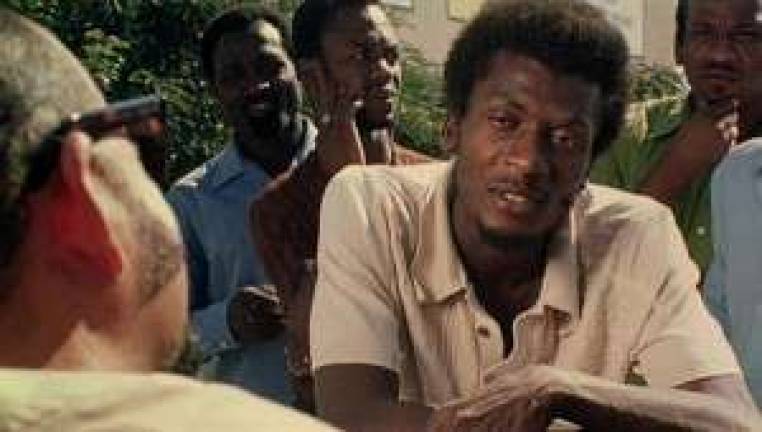From Roots to Toots

By Elena Oumano BAM's 'Do the Reggae' series explores music on screen Jamaican music came into its own in the early '60s, thanks to the advent of cheap transistor radios and the country's 1962 release from British rule. The island's 2.7 million descendants of African captives could now tune in more easily to Miami, New Orleans and post-Castro Cuban airwaves than to stuffy neocolonial emissions from its capital city's official radio station. The rush of joy accompanying independence also carried a new consciousness expressed by a new hybrid music that quickly morphed from mento to ska to reggae, all made and played rough, raw and on the cheap. Reggae's takeover by the burgeoning homegrown Rastafarian spiritual movement expanded the music into a culture that became a force in the worldwide battle against post-slavery Massa. BAMcinématek's "Do the Reggae" (Aug. 2-6) celebrates that independence, its soundtrack, mission and colorful characters, with 14 films testifying to reggae intoxication. 1972 cult classicThe Harder They Come(Perry Henzell) initiated the enduring global romance with Rasta-reggae, and while widely seen on DVD these days, its revelatory charms--a charismatic young Jimmy Cliff in his sole film role, Jamaica revealing for the first time a far more complex and compelling character than her sea, sand and palm tree touristic image-virtually demand big-screen viewing. Fittingly, the festival closes with the world debut ofOne People, directed by Henzell's daughter, Justine, a documentary sourced from people's video submissions recounting what Jamaica means to them. The series opens with a new hi-def restoration of another wildly popular Jamaican film, 1982'sRockers(Ted Bafaloukos), a rollicking Robin Hood fable grafted onto the inevitable Rasta versus Babylon scenario and featuring singing legends like Jacob Miller and Gregory Isaacs who preen, not act, but reveal true genius in as many wonderful live performance sequences as the somewhat forced plot allows. In between is a smartly curated clutch of films, some rarely--if ever--seen here and not available on DVD. Singly, each offers an articulate portrait of this live wire Caribbean island; collectively, they provide a comprehensive, deeply felt view of a tiny nation that more vividly than any other lives out the Third World's ongoing struggles. And if some of the spliffin' Rastamen's rhetoric in these films degenerates after a spell into white noise, who can argue with One Love, especially when it's delivered over languid one-drop beats that restyle space and time? Howard Johnson's threeDeep Roots MusicU.K. docs (1983) distinguish themselves not only with cogent interviews and narration--Mikey Dread's poetic flights--that describe reggae's roots and sociopolitical impact, but with rare footage of near-mythic foundation figures like early toasters Count Machuki and U-Roy;patwapoet laureate Miss Lou; and producer/proto-rapper Lee "Scratch" Perry spouting his trademarked sense and nonsense in his Black Ark studio and on a fishing boat while floating over a crystalline Caribbean sea. There's also performance footage of Count Ossie and the Mystic Revelation of Rastafari, an impossibly young Toots Hibbert and The Mighty Diamonds. Horace Ové's 1971 doc,Reggae, likely the music's first film, is equally incisive, with interviews articulating its outsized impact despite fighting to be heard, even at home, and a revelatory 1971 U.K. concert featuring Toots and the Maytals, Desmond Dekker, the Pioneers, John Holt and Marcia Griffiths, with Bob Andy as its organizing centerpiece. Other docs are better known and avail- able on DVD but still merit a trip to BAM. James P. Lewis'Heartland Reggae(1980) meanders until it reaches One Love Peace Concert footage of Bob Marley holding the hands of political rivals Edward Seaga and Michael Manley above him on stage during his impassioned rendition of "Jamming," an emblematic moment of hope that was soon dashed by the violence of the prime ministerial election. Jeremy Marre's more skillfulRoots Rock Reggae(1977) weaves together jaw-dropping scenes of Joe Higgs singing a cappella; the Abyssinians, Mighty Diamonds and Perry in the studio; and the late, sorely lamented Jacob Miller of Inner Circle. Jerry Stein'sWord, Sound and Power(1980) also provokes wonder at how much talent one small island could produce by dissecting reggae to its backbone, reggae backing band nonpareil Soul Syndicate, while Alan Greenberg's lyricalLand of Look Behind(1982) takes viewers deep into Jamaica's forbidding moonscape interior from which Jamaica's first drumming rebels, the Maroons, terrorized the British plantocracy, as well as to Bob Marley's state funeral. Additional fiction films includeCountryman(1982), which embeds a mouth-watering al fresco ital feast sequence in a hokey take on the Babylon motif, and the bluntly titledBabylon(1981), a U.K. concrete jungle version of same, featuring Aswad's Brinsley Forde. The U.S. is also no stranger to Babylonian machinations against the Black man, so the inclusion of Bahamian-American Sidney Poitier's marvelousBuck and the Preacher(1972), featuring Jamaican-American Harry Belafonte, makes perfect sense. Altogether, "Do the Reggae" packs as much roots rock reggae entertainment as life lessons on cruelties of the ghetto, tropi- cal or elsewhere, literal or figurative. Visit[www.BAM.org](http://www.bam.org/)for schedule and ticket information, as well as information on accompanying events. Captions: Jimmy Cliff inThe Harder They Fall